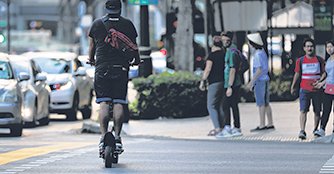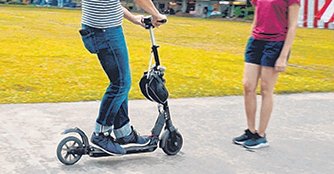CCTV system being tested by LTA to curb errant PMD use
09 Oct 2018|2,375 views
The Land Transport Authority (LTA) is testing a new camera system in yet another move to curb improper riding behaviour on public paths. In response to queries from The Straits Times, the LTA said the system consists of mobile closed-circuit televisions (CCTVs) and video analytics software. They are meant to identify and, hopefully, reduce 'the occurrences of errant riding behaviours on public paths'.
The LTA said the camera system has been deployed along a number of public paths since last November, but it has not determined if it is effective. It does not know how much longer the trial will go on for.
"We will review the findings from the trial and assess how CCTVs and video analytics can complement existing enforcement efforts against active mobility-related offences," a spokesman said.
Incidents related to personal mobility devices (PMDs) and bicycles on shared paths have been on the rise. In response, the Government introduced new rules on 1 May. Within the first 15 days of this, enforcement officers recorded 166 offences.
And between 1 May and 15 August, they recorded 1,300 offences. Observers reckon these may be the tip of the iceberg, as enforcement has so far been limited to manual detection, even though auxiliary police officers from Certis Cisco have been deployed alongside LTA enforcement officers since May.
Others question if a camera-based system would be effective, since many riders wear sunglasses, caps and, increasingly, face masks. Dr. Kwan Kian Hoong, Manager of Temasek Polytechnic's Centre for Clean Energy Research, said it would be possible to embed tamper-proof sensors in PMDs and bikes to track data such as speed and location.
Such sensors by the polytechnic have been on trial in places such as Ecuador and the Philippines. "Technically, it is possible to track," Dr. Kwan said. "But whether to track or not is a policy decision."
Last October, Transport Minister Khaw Boon Wan told Parliament that there were about 90 accidents in the first half of last year involving these vehicles. And the accidents, which mostly took place on the roads, resulted in four deaths and about 90 injuries.
Last month, the Government said rules governing such vehicles will be tightened further from 'early next year'. They will require speed limits for cyclists and PMD users on footpaths to be lowered to 10km/h from 15km/h. Another requirement is that PMD users and cyclists have to 'stop and look' out for vehicles at road crossings. E-scooters must also be registered with the authorities from January.
The Land Transport Authority (LTA) is testing a new camera system in yet another move to curb improper riding behaviour on public paths. In response to queries from The Straits Times, the LTA said the system consists of mobile closed-circuit televisions (CCTVs) and video analytics software. They are meant to identify and, hopefully, reduce 'the occurrences of errant riding behaviours on public paths'.
The LTA said the camera system has been deployed along a number of public paths since last November, but it has not determined if it is effective. It does not know how much longer the trial will go on for.
"We will review the findings from the trial and assess how CCTVs and video analytics can complement existing enforcement efforts against active mobility-related offences," a spokesman said.
Incidents related to personal mobility devices (PMDs) and bicycles on shared paths have been on the rise. In response, the Government introduced new rules on 1 May. Within the first 15 days of this, enforcement officers recorded 166 offences.
And between 1 May and 15 August, they recorded 1,300 offences. Observers reckon these may be the tip of the iceberg, as enforcement has so far been limited to manual detection, even though auxiliary police officers from Certis Cisco have been deployed alongside LTA enforcement officers since May.
Others question if a camera-based system would be effective, since many riders wear sunglasses, caps and, increasingly, face masks. Dr. Kwan Kian Hoong, Manager of Temasek Polytechnic's Centre for Clean Energy Research, said it would be possible to embed tamper-proof sensors in PMDs and bikes to track data such as speed and location.
Such sensors by the polytechnic have been on trial in places such as Ecuador and the Philippines. "Technically, it is possible to track," Dr. Kwan said. "But whether to track or not is a policy decision."
Last October, Transport Minister Khaw Boon Wan told Parliament that there were about 90 accidents in the first half of last year involving these vehicles. And the accidents, which mostly took place on the roads, resulted in four deaths and about 90 injuries.
Last month, the Government said rules governing such vehicles will be tightened further from 'early next year'. They will require speed limits for cyclists and PMD users on footpaths to be lowered to 10km/h from 15km/h. Another requirement is that PMD users and cyclists have to 'stop and look' out for vehicles at road crossings. E-scooters must also be registered with the authorities from January.
Latest COE Prices
August 2025 | 2nd BIDDING
NEXT TENDER: 03 Sep 2025
CAT A$104,524
CAT B$124,400
CAT C$72,190
CAT E$125,001
View Full Results Thank You For Your Subscription.





















